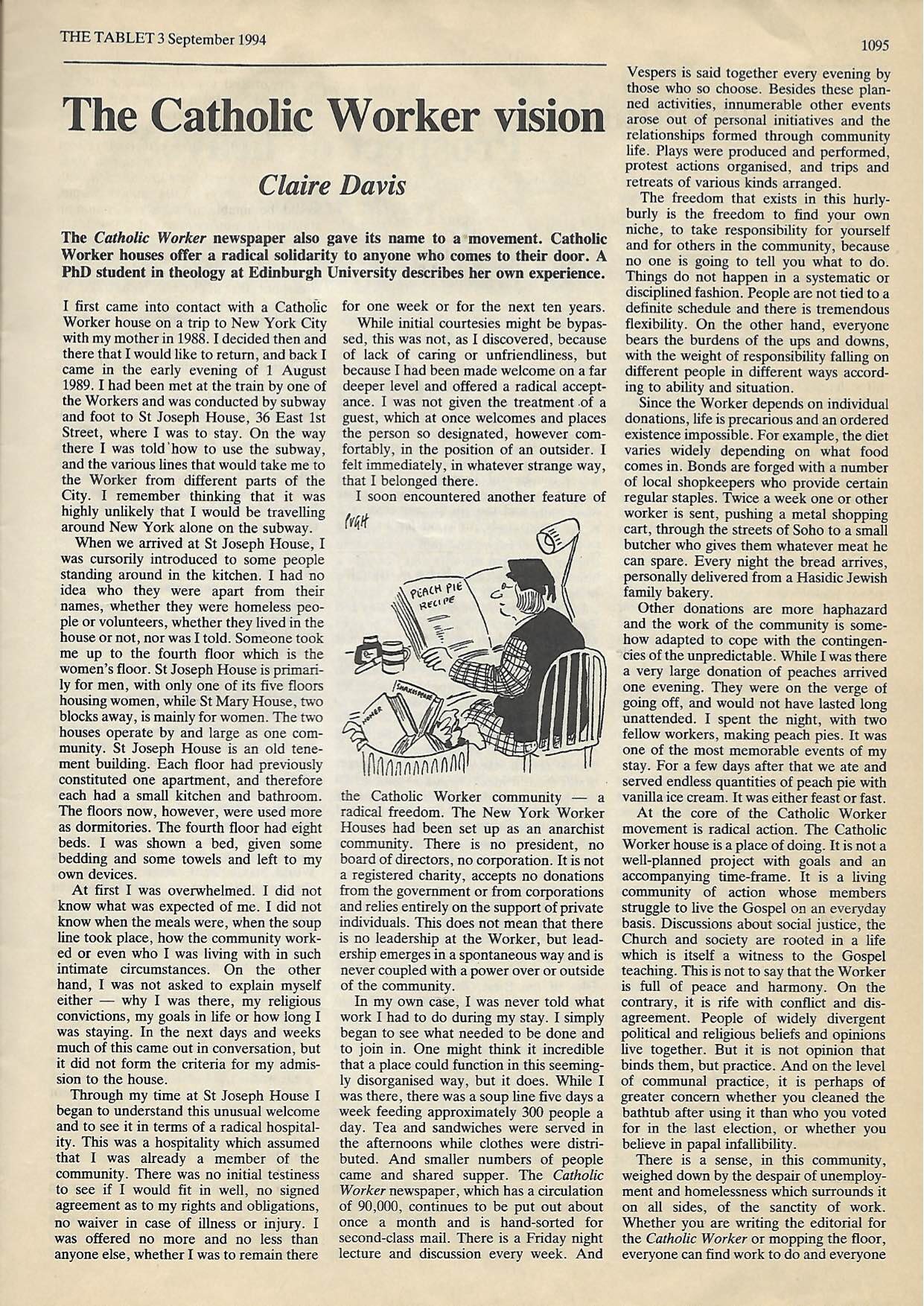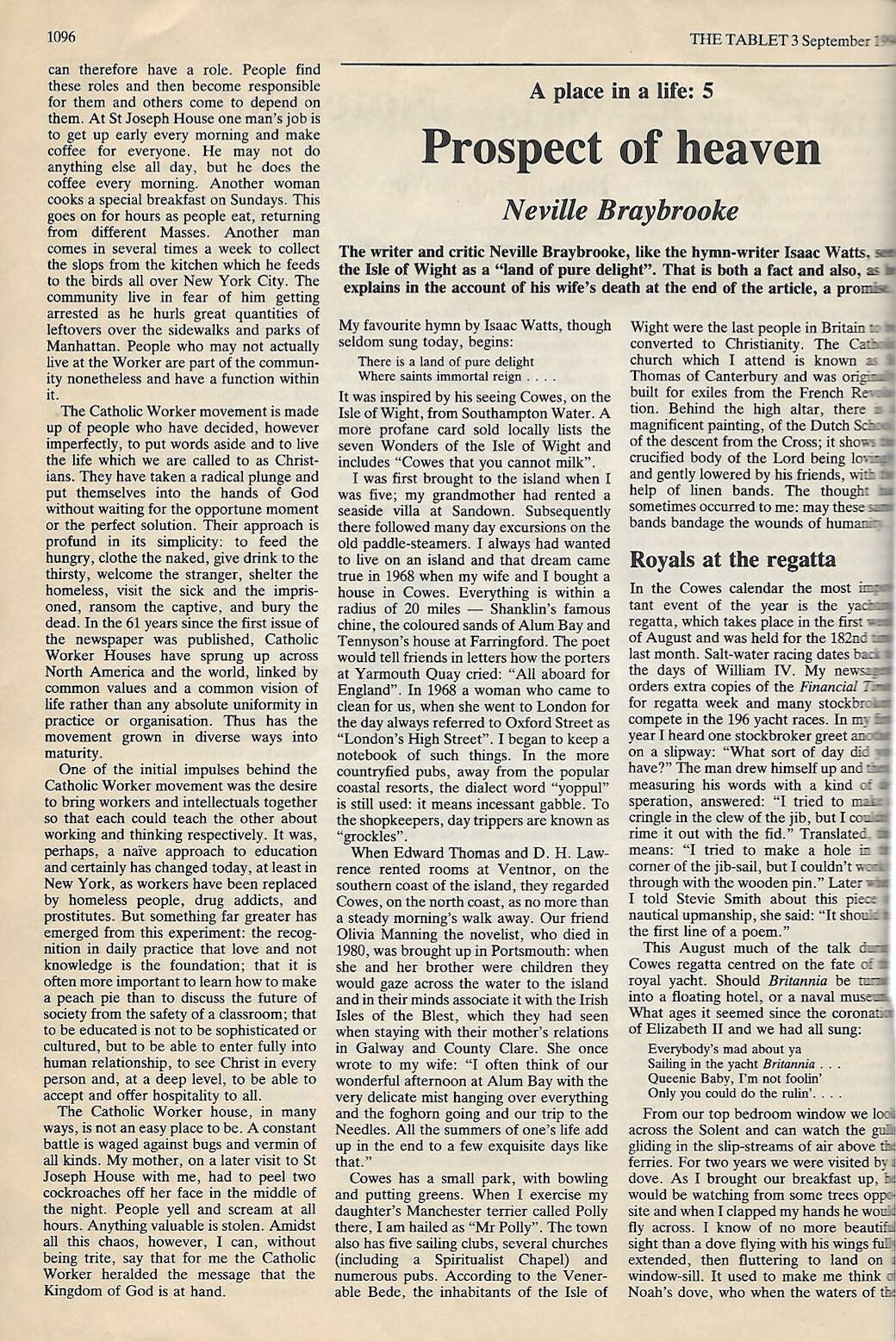An Easter love letter to Pope Francis
April 11, 2020
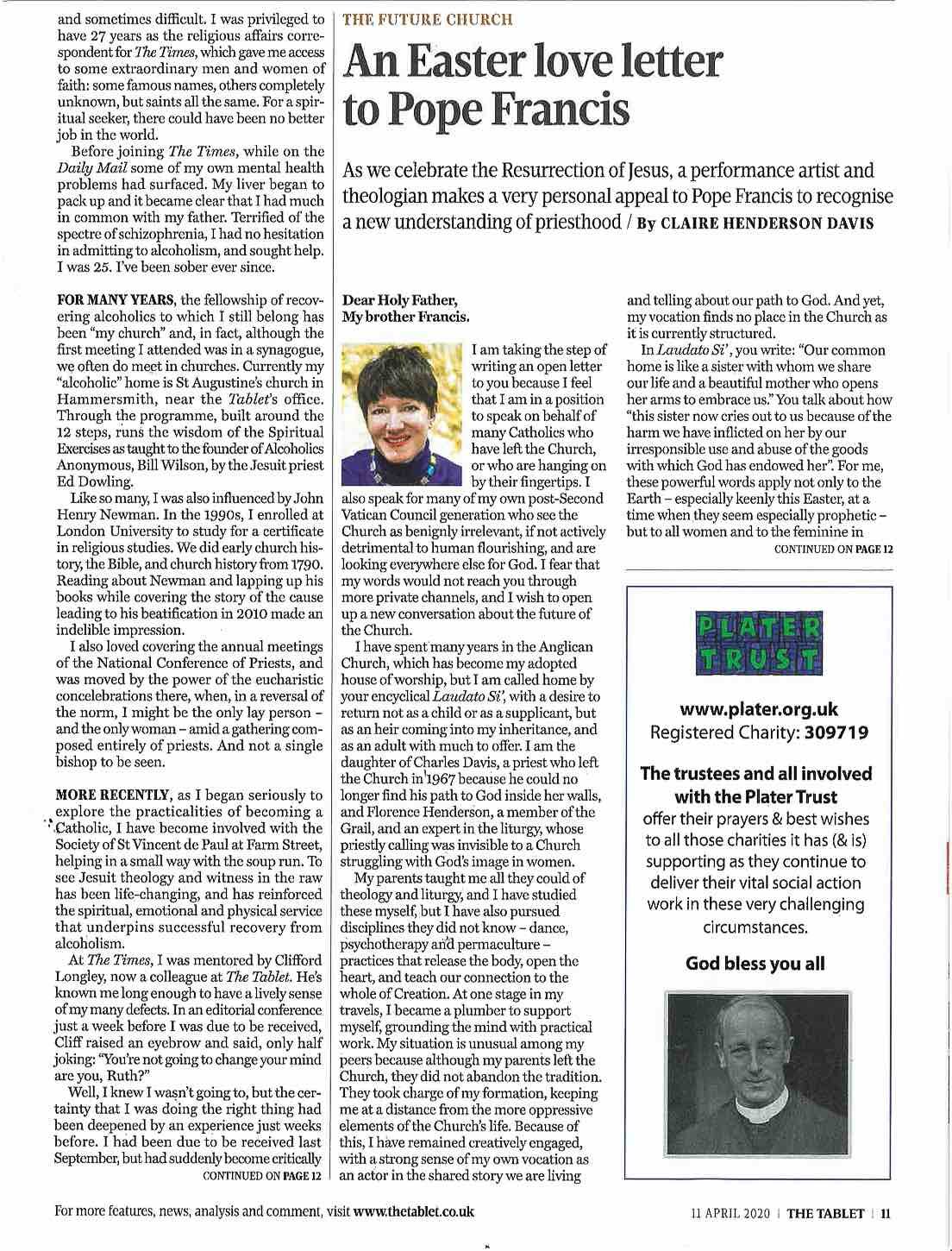

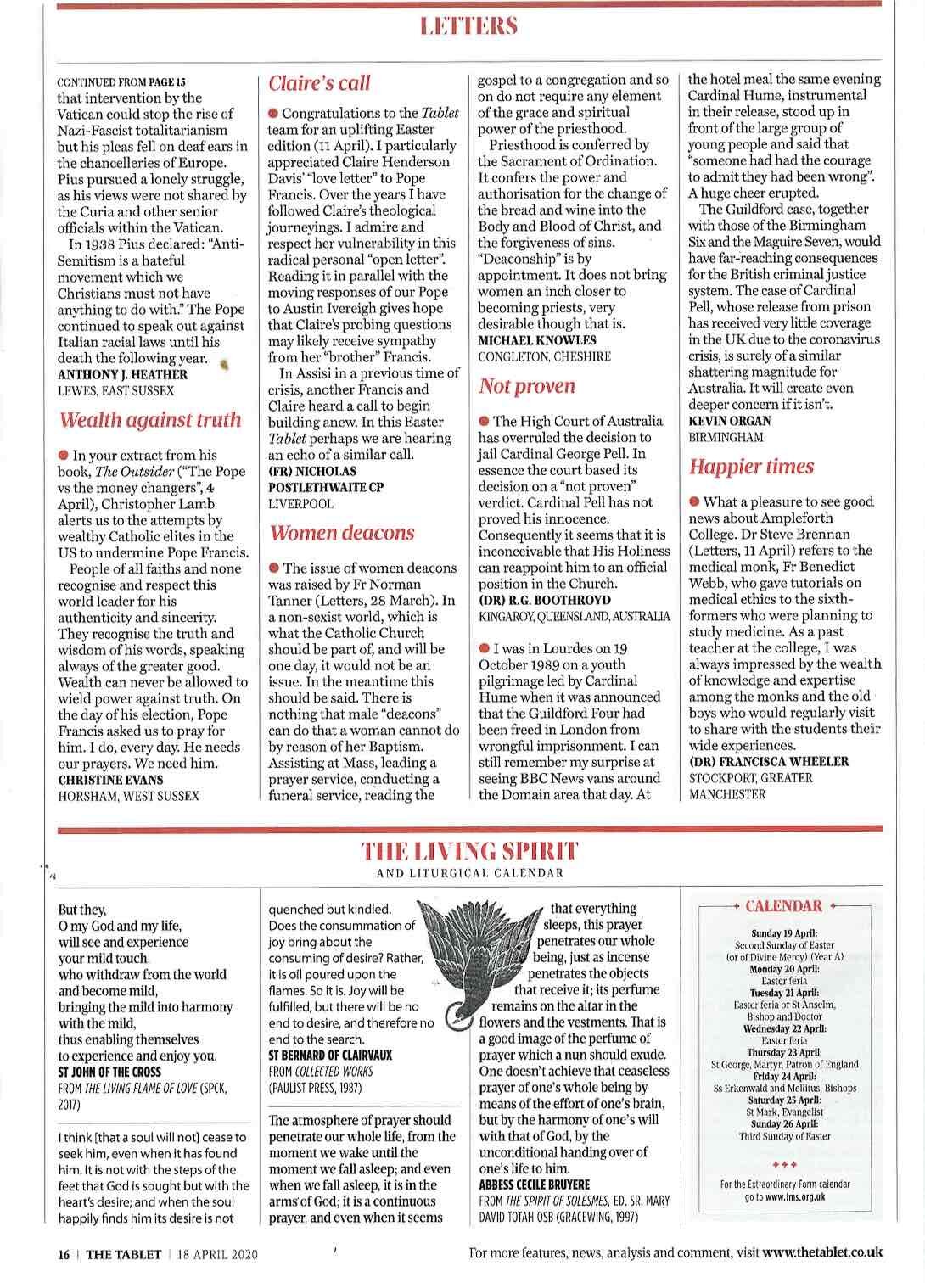
CHURCH TIMES INTERVIEW
back page interview
‘I spend a lot of my time telling people that I’m not doing liturgical dance’
Claire Henderson Davies, performance artist, theologian
I created a contemporary performance of the Passion for Ely Cathedral in 2014, in dance, poetry, and music. It went on to tour other cathedrals in 2015. We performed at Chester Cathedral in March last year, and this led to a conversation about my engaging with their life over a longer period of time.
This residency is the first time in my career that I have such a sustained level of support. Up to this point, all my work has been project- based, which means that I’ve been caught up relentlessly in short-term funding cycles as well as trying to keep my work going. Knowing that I’ve got three years gives me room to breathe and expand.
I hope to make a significant contribution to the liturgical life of the cathedral, as well as to create a more sustainable framework for my own practice.
My training is in contemporary dance and theatre. We chose the title “performance artist” rather than “dancer” to describe the residency, because much of what I do isn’t what most people imagine dance to be, though it comes out of a recognised tradition in contemporary dance. “Performance artist” offers broader scope, and doesn’t set up the same expectations.
I was seriously involved in theatre from the time I was a small child. As part of this interest, I took dance classes; but my focus shifted to dance when I was doing my Ph.D. in theology in Edinburgh. I had terrible writer’s block, and had the intuition that dancing would help me.
I began taking class — including contemporary technique, improvisation, and choreography — at Dance Base, which has significant links to international companies; and had the chance to do master- classes with some of the most exciting companies and choreographers in the world, including Saburo Teshigawara, Philippe Decouflé, and William Forsythe.
It worked: dance allowed me to carry on working on my doctorate, and to come to some intellectual understanding about where I had come from.
When I moved to London, I continued training at the evening school at The Place, and started taking classes with Gaby Agis, who teaches Skinner Releasing Technique, which became a huge influence. I also did some training in contact improvisation.
My own approach emerged from all these different strands. I’m particularly interested in creating work that draws people’s attention to ordinary, everyday ways of being in the body, calling into question and transforming habitual patterns.
My own concern with any art used in the liturgy is that it should connect with people rather than create an alienated distance. This doesn’t mean that it is easy or dumbed down: it means that it creates a relationship. Many, if not most, people are unfamiliar with the language of dance, and the danger is that they’d say: “That’s lovely, but I could never do that.” I’d describe my approach as parabolic — beginning, as Jesus does in the parables, with a familiar setting, and then making the familiar strange. So the work is about taking people on a transforming journey.
I spend a lot of my time telling people that I’m not doing liturgical dance. This is probably terribly ignorant and prejudiced of me, but my own limited experience of liturgical dance is of people in long, flowing robes waving their arms around, and I have a great desire to distance myself from this aesthetic.
The choreographer who has influenced me the most is Pina Bausch, and this is the dance tradition I most identify with: an edgy, emotionally articulate, emotionally risky exploration of human relationship through movement.
I’ve always had a powerful sense of God, which I would describe as a sense of connection to a reality greater than myself. .
The language I use about God has changed and grown over the course of my life, and it’s obviously deeply shaped by the religious tradition in which I’ve been formed; but this language feels secondary to an abiding sense of living in relationship to a mystery that language cannot contain.
The Church needs to move from a parent-child model to a more adult model in its liturgical life. This is significant for the choreography of movement in the liturgy. At the moment, the clergy stand at the front, facing the congregation, in a parental position, while the congregation moves corporately: standing, sitting, and kneeling together. As adults, however, we need to have space in which we can each explore our individual bodies and ways of moving.
I’m not talking about losing the communal aspects of the liturgy, but about creating space for individual, adult exploration, and for t exploring adult relationships as the context for our relationship with God — meeting the divine in each other. This requires a new form of spiritual discipline and practice, and that is what I’m working on in my dance. I also bring to this approach an extensive, and essential, back- ground in psychology. I did a ten- year Jungian analysis, and am now training as a Gestalt psychotherapist.
I was raised inside the Roman Catholic tradition, but outside the authority structure of the Church, and this left me with an urgent need to work out for myself my relationship to Christianity. My father, Charles Davis, was a Roman Catholic priest and theological adviser at the Second Vatican Council, and then left the Church to marry my mother, who was a member of the Grail, a movement of lay Roman Catholic women.
This search took the form of a Ph.D. in Theology at the University of Edinburgh, but I was never going to be an academic. At the same time that I submitted my thesis, I choreographed a piece called Eucharist, and this was as much the fruit of my search as the thesis itself. I would describe myself as a “practice-based liturgical theologian”.
Cathedrals are an ideal environment for movement, because they are large and full of open spaces. Much movement already takes place, such as liturgical processions, and the progress of visitors around the building.
Whatever dance takes place, in my view, needs to build on the movement patterns that are already familiar to people in the cathedral context. Dance can open up new possibilities for relationships in the congregation and in the wider community. In my first dance intervention in the liturgy at Chester, I included a man who does maintenance work on cathedral properties. Including someone in a hard hat and high-vis jacket expresses the present life of the cathedral in a way that wouldn’t normally come into a more traditional liturgy.
We’re starting the Chester Cathedral Public Workshop, drawing on the Greek root of “liturgy”, meaning “public work”, as a new framework for explorations that go beyond the traditional liturgical structure.
All cathedrals would benefit from this kind of residency, but some- thing particularly exciting is going on at Chester at the moment, which made me want to come here. There’s a spirit of exploring new possibilities, and reaching beyond the familiar, which created a synergy and sense of excitement when I came to perform here last March.
I grew up in Montreal, Canada, at a time of considerable political unrest. I was born in Edmonton, but moved with my parents and brother to Montreal when I was six weeks old. At the time, Quebec was under martial law because of the kid napping of two government officials by the French separatist group, the FLQ. My parents sent me to a French-Canadian school, not realising how hard it would be to be an English-speaking kid in that environment at that time.
That made language problematic in my life, and it’s part of the reason that the language of the body is so primary for me. I can easily feel lost if I try to communicate with words alone.
I love the sound of rain on the roof.
Before coming to Chester, I lived in a mobile home in Waterbeach, outside Cambridge, and the sound of rain was incredibly loud and vivid. Cosiness that comes from hearing rain on the outside, enjoying the rhythms it makes, but being warm and dry inside.
I was trying to sort out car insurance on the phone yesterday, and was faced with an intractable bureaucracy trying to fit me into categories that don’t apply to my life. That made me angry. The autobiography of the choreographer Yvonne Rainer is called Feelings are Facts, and I rejoice in that title because it conveys a truth that is often lost. I’m happiest when in the company of the people I love.
I’d say I have been most influenced by my parents, the songs of Leonard Cohen, the choreography of Pina Bausch, and the theology and mentoring of Rowan Williams.
I pray for the ability to be present in the moment, to still my mind and listen.
I’d like to be locked in a church with Nigella Lawson as long as we could use the church kitchen. She strikes me as warm and nourishing — a fellow creature of the flesh. I’d like to cook a delicious meal with her, and talk into the small hours.
Claire Henderson Davis was talking to Terence Handley MacMath.
www.clairehendersondavis.com; www.passiontour.org; chestercathedral.com.
Sun 19 Mar 2006 01.32 GMT First published on Sun 19 Mar 2006 01.32 GMT
LIFE WITH MY FATHER, THE REBEL PRIEST
The Da Vinci Code court case has renewed interest in Charles Davis's theory, first explored in The Observer, that Jesus could have married. Here the priest's daughter, Claire Henderson Davis, tells how her father found in his own marriage a sacred love that the church could not offer.
Claire Henderson Davis
My father's concern with the question 'Was Jesus married?' undoubtedly came from his own experience. For 20 years he lived as a celibate Roman Catholic priest; then, in 1967, he left the priesthood to marry my mother.
His was not a private decision. He left in a blaze of publicity after holding an international press conference to denounce the Roman Catholic church as an obstacle to real holiness. He did not lose his faith, but set out on the path of marriage looking for a new kind of holiness that included active sexuality at its heart. It seems logical that his reflections on the possible marriage of Jesus came out of this personal exploration.
The Da Vinci Code is so threatening to the church because it imagines a tradition kept alive outside the control of the church's authority. My parents, in a sense, lived out this myth, raising my brother and me within the tradition, but outside the institution, discarding those elements they knew to be dead or harmful.
My mother was a member of the Grail, a Catholic lay movement that wanted to give women an alternative voice. I think my parents did find a kind of holiness, but their path together was no easy stroll into the sunset holding hands. Both were virgins when they married - my mother was 39, my father 44. Both brought with them 20 years of living in Roman Catholic institutions, and a lifetime of Roman Catholic teaching on sex. Faced with the reality of living intimately with another person, they had a lot of untangling to do.
Both came from Catholic families where sex was not discussed, and having had no experience, they had no personal language to talk about sex to each other. My father probably found it easier to write about the possible sex life of Jesus than to discuss his own sexual desires. It was taken for granted that my father's career would take precedence, and in many ways, my mother, a vibrant and creative individual, was sidelined by his success.
Perhaps Jesus was not married because a real marriage between equals was not possible in his day. Women were not considered equal to men. Jesus's equal treatment of women was prophetic in its time, but he could not have married a woman without assuming authority over her. Maybe what The Da Vinci Code gives us is not an accurate picture of what really happened between Jesus and Mary Magdalene, but an accurate expression of our contemporary desire to portray sex between equals as sacred.
My parents' equality was hard won and didn't really come until late in their marriage. For the last 15 years of his life, my father suffered from Parkinson's disease. An intellectual man, he gradually lost the ability to write, then to read, and finally to sustain a conversation. He was confronted with his own vulnerability. Once so reserved, he became uninhibited about expressing his feelings, and started writing poetry. At the same time, my mother had to assume more responsibility for their life. In this reversal of fortune, they assumed a new level of equality since neither could take the other for granted.
Images of sex in the media encourage us to think that a successful sexual relationship hinges on physical beauty and technical prowess. But if we think of sex as an adult language, a form of conversation between equals, a different vision of success emerges based on reciprocity, mutuality and equality. We might say that we live in a sexual age in the sense that these values govern our aspirations not only in the bedroom, but in the way we structure society. It is the claim sex makes to adulthood that really frightens the Catholic church, with its emphasis on child-like obedience. My parents, by leaving the church, were asserting their own adulthood. What they then faced were the parts of themselves that hadn't yet grown up. They were like musicians breaking from the orchestra to improvise. The sounds they produced didn't always make good listening, but over time they learnt to play together. Christianity is ultimately about being human, and if this way of life doesn't bear fruit in human terms, there is something wrong with how it's getting expressed.
So what kind of fruit can it bear? If I look at my parents' lives, it probably wasn't great sex. They began too late in life, with too many obstacles to overcome. For them it was fidelity to each other over 32 years of marriage, and fidelity to the path they had embarked on together. This involved a radical openness to the world, which enabled them to keep growing and changing right until their deaths. On my parents' tombstone the epitaph, taken from one of my father's poems, reads: 'Love not knowledge is the answer, feeling not logic is the process.' This insight is probably the greatest fruit of their marriage, a commitment to a particular way of life, accepting the suffering as well as the joy it brings, without knowing where it's going to take you.
Journey across the desert
January 25 1997

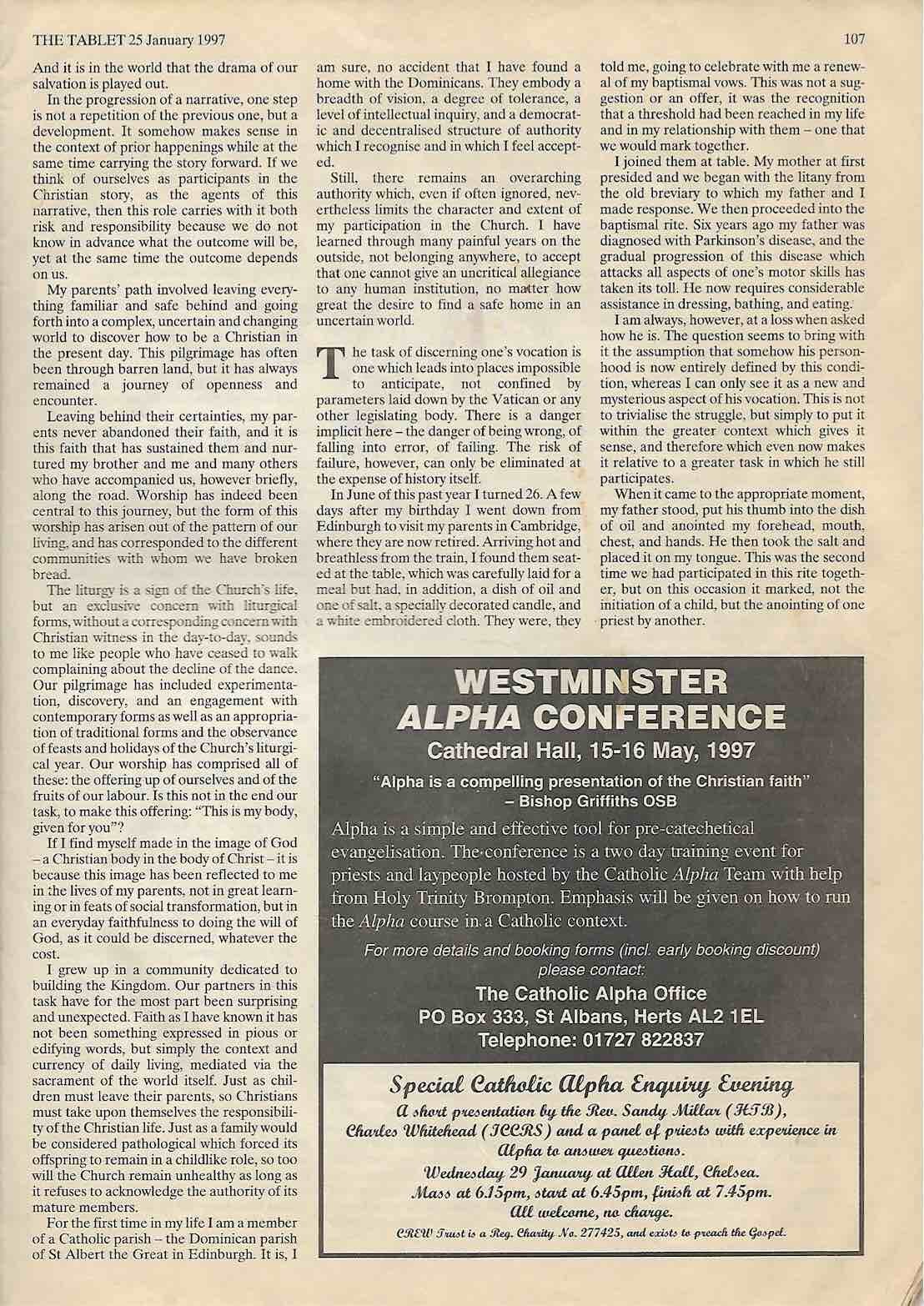
The Catholic Worker vision
September 3 1994
